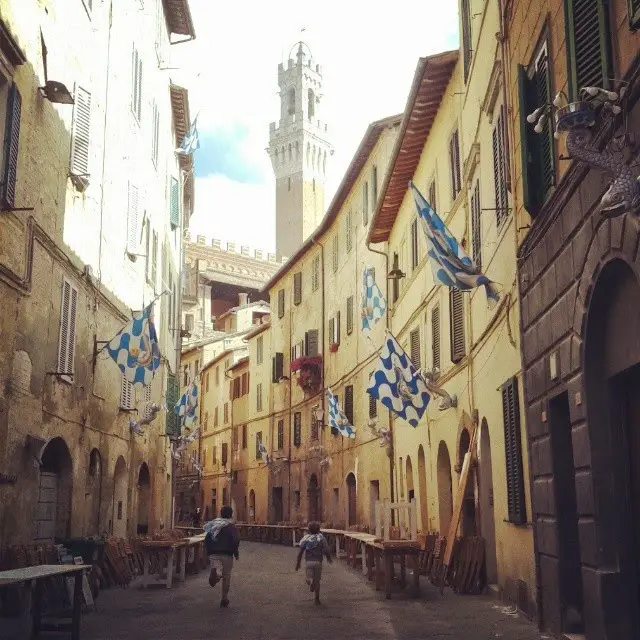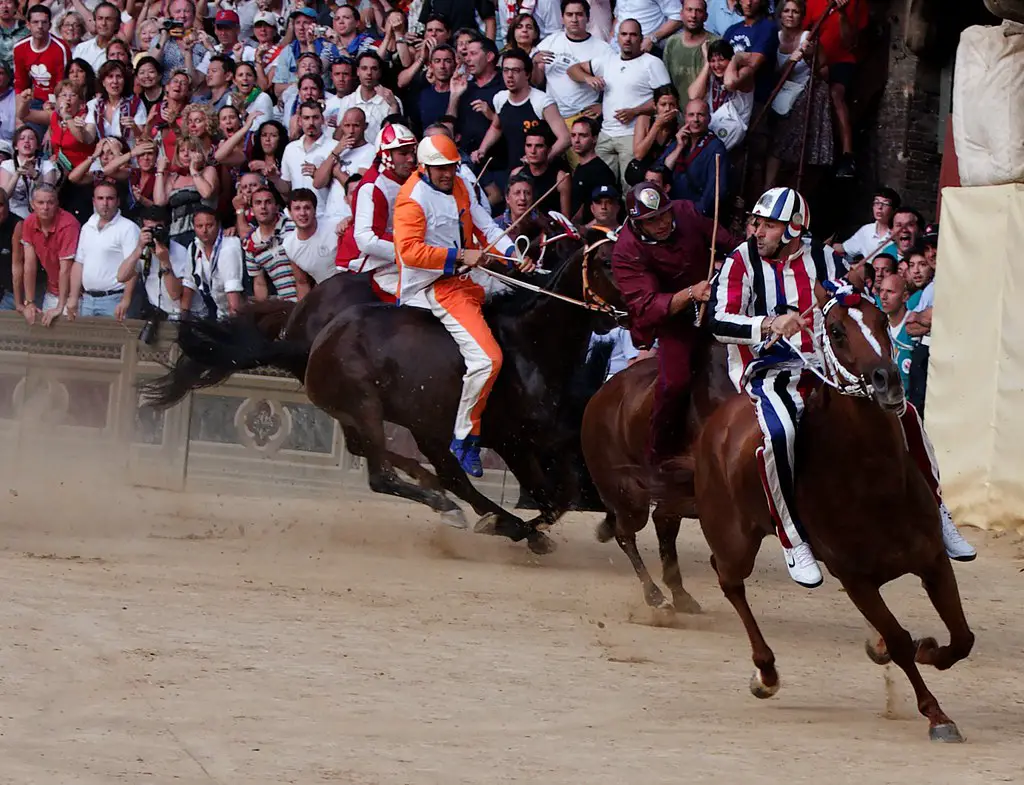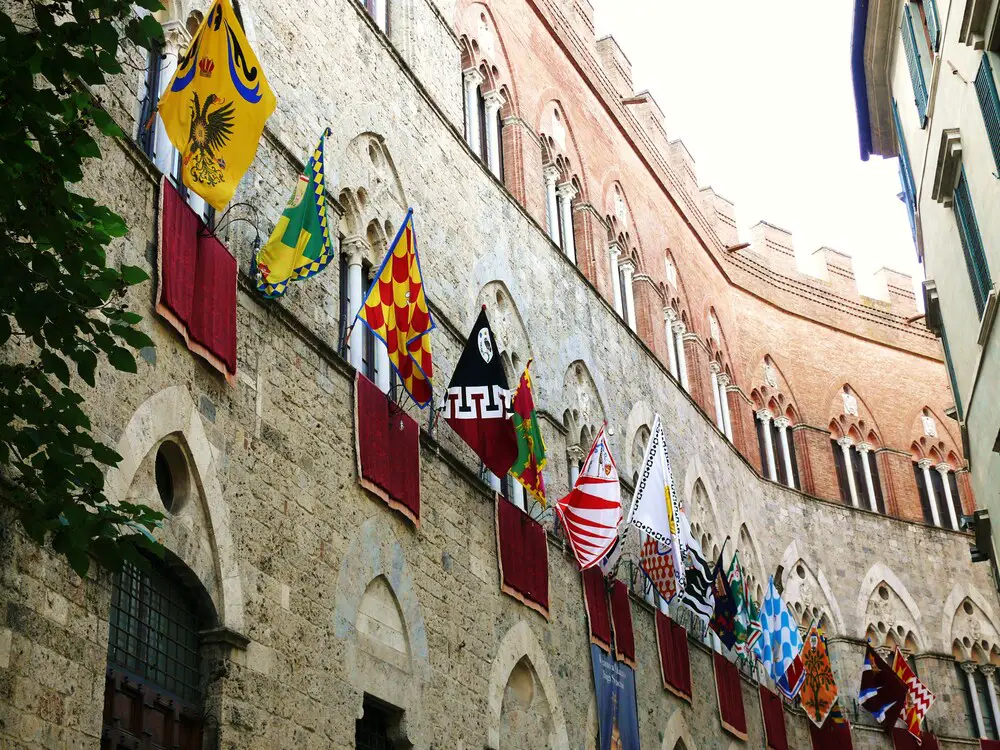If you are visiting Siena in Tuscany, you have to know some facts about its biggest event of the year, called the Palio. When walking down the city streets, you will see various flags hanging from the windows. Each of them represents one neighborhood that participates in the biggest and most iconic horse race in Italy.

Even though every tourist guide talks about the Palio, not many of them will tell you everything you have to know. Here are the twelve must-knows for people wanting to impress fellow travelers with their thorough knowledge of the Palio di Siena, the world’s oldest continually held sporting event.
What is the Palio?
The Palio is Italy’s most famous horse race that takes place twice a year on Piazza del Campo, Siena’s shell-shaped medieval square. It attracts about 40,000 spectators in the Piazza del Campo and about 100,000 people in the city during the days of the race. This event is a unique experience that combines history, culture, and tradition in a spectacular show.
When can you see the Palio?
The Palio is held each year on the 2nd of July and the 16th of August. The July race, called Palio della Madonna di Provenzano starts at 7:30 PM (19:30 hours), while the Palio dell’Assunta is in August at 7:00 PM (19:00 hours). However, both races are proceeded by a pageantry procession, so prepare to access Piazza del Campo three to four hours before the start of the race. The festival lasts for a total of four days each time, which are made up of trial races and neighborhood dinners.
Who can participate in Palio?
Siena has 17 neighborhoods (contrade in Italian), but only ten of them can participate in each race. The seven contrade that aren’t running the July Palio in the current year are designated to participate in the July Palio the year after (the same system applies for the August Palio).

To make up the total number of participating contrade, a month before each Palio three additional neighborhoods will be drawn out of the ten contrade which have run the race the year before. This means that of the two Palios each year, a contrada may be running both, one, or – in unlucky cases – none at all.
What is a contrada, and how many are there?
A contrada is a neighborhood or tiny city district in Siena’s historic town center. Each of the city’s 17 contrade is made up of just a few roads but has its own museum, a stable for the horse, and a church where mass and horse blessing take place on the day of the race. During the rest of the year, the museum is in constant use for meetings and neighborhood dinners.
Most contrade also have a fountain where every new contrada member is “baptized” and welcomed as a member of the neighborhood. This means that while everybody can be a fan of a contrada, you are only able to be a contrada member if you are born in the particular Siena neighborhood.
The names and symbols of Siena’s 17 contrade
| Name | Symbol |
| Aquila | Eagle |
| Bruco | Caterpillar |
| Civetta | Owl |
| Chiocciola | Snail |
| Drago | Dragon |
| Giraffe | Giraffe |
| Istrice | Porcupine |
| Lupa | She-wolf |
| Nicchio | Seashell |
| Oca | Goose |
| Onda | Wave |
| Pantera | Panther |
| Selva | Forest |
| Tartuca | Turtle |
| Torre | Tower |
| Leocorno | Unicorn |
| Montone | Ram |
Most contrade are easily recognizable as the animal they are named after also appears on their flag and on the ceramic plates and statues in the neighborhood. Not named after an animal, but still represented by one are three neighborhoods: Onda (wave), with the symbol of a dolphin, Selva (forest) represented by a rhino carrying a few trees and Torre (tower) by an elephant carrying a tower.
Since when has the Palio been run in Siena?
Siena’s bareback horse race is one of the oldest continuously happening festivals in the world. The tradition started with bullfights, horse races, and other public games held on Piazza del Campo in the Middle Ages. The Palio di Siena horse race has taken place in its current form since the 17th century. However, similar horse races are also run on a smaller scale in other Italian cities. But only in Siena has the race been continuously run since the Renaissance.
How long does the race last?
The race itself is pretty short. Still, tourists and neighborhoods wait for 365 days of the year for the race, which culminates in 1 minute and 15 seconds (the time needed for the three rounds on Piazza del Campo) on the 2nd of July and the 16th of August.
Why is the race called Il Palio?
Il Palio is the name of the painted silk cloth that the winning contrada will bring home (there is no price money involved in the race). The Palio cloth is also called drappellone or cencio in Siena, and each contrada proudly exhibits the won Palio at its museum. The oldest still existing Palio dates back to 1719 and can be seen at the museum of the Aquila neighborhood.
The silk clothes are traditionally painted by local artisans, but in more recent decades, also by internationally known artists. Contrada Tartuca’s museum exhibits Palios painted by Sandro Chia, Fernando Botero, and Igor Mitoray.
Facts about the jockey
The fantino (jockey) is only chosen once the contrada knows which horse it will be running with (the horses are drawn on the first of the four Palio days in Piazza del Campo). The jockey is paid by the contrada, and at times, agreements are taken between different contrade amiche (befriended neighborhoods) so as to help each other against a common enemy.
Jockeys negotiate until the last moment before the race starts and offer each other sums of money for support in case of the defeat or victory of a particular neighborhood.
The Palio horses
The horses are the most important players in the Palio race. This is the reason why horses are venerated like saints in Siena. A horse that loses its jockey during the race can nevertheless win as long as it still wears the colors of its Contrada when arriving at the finishing line (this happened last time in 1996). The horses are bred especially for the Palio and are blessed in a special mass in each contrada on the day of the Palio.

However, the sloping Piazza del Campo and the heated nature of the race make it a dangerous event for horses and jockeys alike. Conditions have been massively improved over the last decades thanks to better protection and special selection and training of suitable mixed breed horses. Nevertheless, accidents keep happening. Italian animal rights movements are constantly monitoring the conditions of the race and requesting further improvements.
The animosities between the contrade
Enemy contrade are, in many cases, adjacent neighborhoods, and rivalry stems from century-old quarrels in regard to the exact territory of each contrada. At times, alliances are installed between neighborhoods so as to improve each other’s chances of winning a Palio or to lessen the ones of an enemy contrada.
Only Bruco, Giraffa, and Selva don’t have a rival contrada. Of the remaining 14 neighborhoods, the enemies are:
| Oca and Onda | vs | Torre |
| Civetta | vs | Leocorno |
| Nicchio | vs | Montone |
| Istrice | vs | Lupa |
| Aquila | vs | Pantera |
| Ciocciola | vs | Tartuca |
The race is a real medieval game in modern times. Jockeys often work mercenary style for the best-paying contrada and will change neighborhoods from race to race. While the jockey is meant to bring home the Palio, he is also supposed to prevent the enemy contrada from winning.
This can be well seen in the July 2013 video where the fantino of il Nicchio (wearing dark blue in the back) is supposed to start the race but keeps biding time until his enemy from the Montone neighborhood (in the salmon-colored outfit on the left) is blocked by other horses. Right at the beginning of the race, you can also observe how the jockey of the Istrice neighborhood (in a stripy outfit) keeps hitting the jockey of its enemy, contrada, la Lupa (wearing black and white colors).
How to watch the Palio for free?
Access to Piazza del Campo is, in fact, free for everybody during trial runs and the two Palio races in July and August. The atmosphere in the square is amazing, but make sure you bring sunscreen and a hat (water can be bought on the square or bottles refilled at the Fonte Gaia fountain).
Seated viewing on the wood tribunes and from the houses around the square is only available on payment (prices start from 250 euros). Tickets have to be booked well in advance. There is no official vendor for Palio tickets, so it makes sense to shop around. Also, remember that there is no access to toilets from inside the square and from most tribunes.
Before coming out, check the schedule of the trial runs and main races to plan your stay. For in-depth Palio insight (and after 500 years of history, there is a lot more to know!), check the website of ilPalio.org with films from the race all the way back to 1936. Once back home, be sure to follow Siena’s famous race each year live on TV or via streaming. And don’t forget to open a bottle of Tuscan wine with it.
Check out more articles about Siena:
- Things to see in Siena
- Best Pizza in Siena
- The best place to park in Siena
- How long to spend in Siena?

